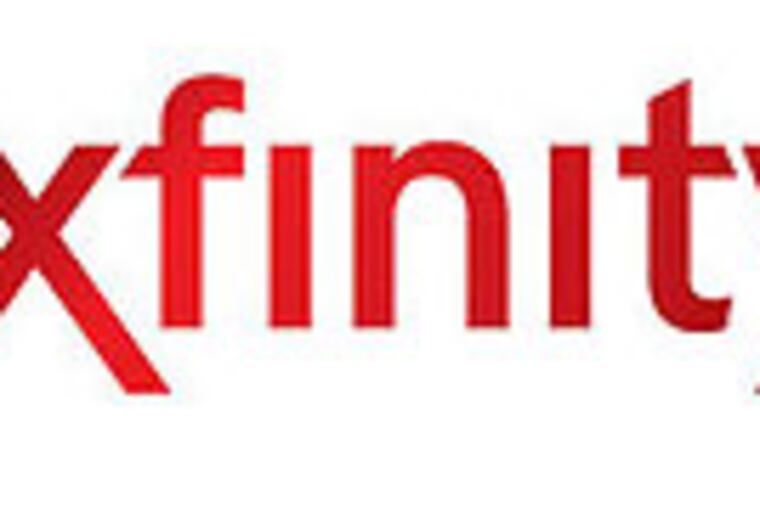Comcast unveils new brand name and logo
The Comcast cable guy and his truck are getting a new look. Comcast Corp. said yesterday that it would re-brand its TV, Internet, and telephone services as Xfinity on Feb. 12 to signal to customers that this isn't the same old company.

The Comcast cable guy and his truck are getting a new look.
Comcast Corp. said yesterday that it would re-brand its TV, Internet, and telephone services as Xfinity on Feb. 12 to signal to customers that this isn't the same old company.
Comcast will remain as the corporate name, but the company will emphasize Xfinity in advertisements and on 24,000 service trucks and thousands of employee uniforms.
The new brand name will first appear in Comcast ads, around the time of the Winter Olympics, in Philadelphia and 10 other markets and will then appear in Comcast's cable-franchise areas in other parts of the country.
"This is a pretty big moment where we are upgrading every product area," David Watson, executive vice president of operations, said yesterday in an interview.
He said the new name communicates Comcast's constant product upgrades and innovation.
Comcast officials said the new brand name would not change any customer's e-mail address. The name will appear eventually as a logo on the Comcast TV guide and Web sites, and will also appear on customer bills under headings for different services. For example, instead of being called Comcast Internet, it will refer to Xfinity Internet.
Comcast had a Web site, Xfinity.com, online yesterday announcing, "A new era of entertainment is about to begin." The words appeared on a background of clouds and bursting sunlight, but no other content was available.
Xfinity seems to position the company to compete with Verizon Communications Inc., which markets its TV and Internet services as FiOS, and AT&T Inc., which uses U-verse. Cablevision, the New York-based cable company, sells its services under the brand Optimum.
"Verizon has FiOS. Comcast now has Xfinity. It's rebundling it in a high-tech package. You are rebundling an improved product, an enhanced service," said Marc Brownstein, president and chief executive officer of the Brownstein Group, a Philadelphia brand communication, public relations, and advertising firm.
This re-branding comes as Comcast has struggled to rebuild its reputation because of poor service and problems with its network that resulted in telephone and Internet outages. Its customer-satisfaction rating is among the lowest in the industry, but it has improved slightly in the last year.
Not a distancing ploy
Comcast spokeswoman Jennifer Khoury said the re-branding was not an attempt to distance the service from the Comcast name. "This is about our product. It is about providing our customers with products that just keep getting better."
Claes Fornell, a business professor at the University of Michigan and head of the American Customer Satisfaction Index, said that Comcast had improved its satisfaction ratings lately, but that the Comcast name "still has some baggage."
He said of the new name, "I'm not sure whether it will stand out. 'Comcast' stands out."
Comcast disclosed its plans while discussing its fourth-quarter earnings.
"The important message to our customers is that Comcast is innovating in all our products across many platforms, giving these customers even more choice and control over the entertainment, communications, and information they want," Comcast chief executive officer Brian L. Roberts said in the earnings conference call with analysts.
"We are not only repositioning the company technically, we are repositioning the company with consumers," Roberts said.
Revenue is up 2.9%
Revenue for the quarter ended Dec. 31 rose 2.9 percent as competition and the weak economy snuffled higher growth. Revenue was $9.1 billion compared with $8.8 billion in the year-earlier period.
Fourth-quarter net income soared 132 percent from a year earlier, to $955 million, aided by a favorable federal tax settlement that was worth $130 million.
For all of 2009, Comcast's revenue rose to $35.8 billion compared with $34.4 billion in 2008. Net income was $3.6 billion in 2009 compared with $2.5 billion in 2008.
Chief operating officer Stephen Burke, in the conference call, said Comcast was striking back with programs to more aggressively battle telephone giants' expanding TV and high-speed Internet businesses into Comcast cable-franchise areas.
Comcast tried to keep more customers happy by limiting its cable rate increases to 6.9 million subscribers in late 2009 compared with 16.2 million customers in the fourth quarter of 2008, Burke said. The company has about 24 million cable customers.
Burke has noted that Comcast has been on a tear by boosting its Internet speeds, offering more TV channels as a result of its digital transition, and is adding features to its new phone service.
Comcast added 247,000 high-speed Internet customers in the fourth quarter, compared with 184,000 new customers in the same period in 2008.
The company lost 199,000 video customers in the fourth quarter, a slight improvement compared with the loss of 233,000 video customers in the fourth quarter of 2008.
Comcast added 1 million high-speed Internet customers and 1.15 million phone customers in 2009, but it lost 623,000 video customers.
The cable giant announced its fourth-quarter and full-year earnings one day before Roberts is scheduled to testify before two congressional committees in Washington on Comcast's proposed merger with NBC Universal Inc.
Company shares closed down 32 cents at $15.97.